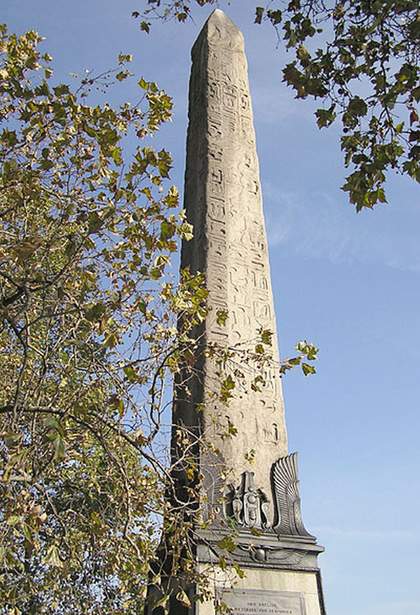
Fig.1
Cleopatra's Needle, Victoria Embankment, London
In modelling the main figures of The Singer and Applause, Ford obviously did not adopt what the mid-Victorian art theorist Owen Jones described in the Description of the Egyptian Court Erected in the Crystal Palace (1854) as the ‘peculiar character’ of ancient Egyptian sculpture.1 As evidence of how this was perceived, the comments of Victorian journalist Samuel Sharpe in the same publication are revealing: Sharpe condemned the ‘simple’ attitudes of Egyptian sculpted figures, the way in which figures looked ‘straight forward’, ‘whether standing or sitting’, the manner in which fingers and toes tended to be ‘straight and unformed’, the unrealistic shortness of the figures’ waists, and the fact that there was little apparent interest in portraiture, motion or facial expression.2 Nevertheless, Ford’s statuettes reveal his real and wide-ranging interest in Egyptian and Egyptian Revival material, in a variety of scales, in a diverse array of media, and from a disparate range of locations. These interests are reflected in the statuettes’ religious and musical themes, in the hieroglyphics Ford employed on the bases of The Singer and Applause, in the harp and architectural shape of the pedestal of The Singer and in the details of the statuettes’ hairstyles and headdresses.
The vast majority of the ancient Egyptian objects that Ford studied derive from the British Museum, but other sources clearly employed by the artist indicate that he also visited the Egyptian collections in the Louvre in Paris, that he was familiar with contemporary painterly depictions of Egyptian antiquity (especially within the aesthetic movement by artists such as Sir Lawrence Alma-Tadema), that he may have attended one of the early performances of Giuseppe Verdi’s opera Aida (1869–71), and that he was familiar with at least one of the most influential travelogues relating to the discovery of ancient Egypt. In addition, Ford would have been familiar with the material culture of Egypt as it was laid out on the Thames Embankment, where the so-called ‘Cleopatra’s Needle’ c.1500 BC had been erected in 1878 (fig.1), joined by two sphinxes and a sequence of Egyptian Revival benches. It is also known that Ford visited the Egyptian Hall of the Mansion House in Piccadilly, because, as an anonymous contributor to the Builder’s Journal of 6 August 1895 documented, the sculptor’s c.1891 commission for the Strathnairn monument was first discussed with him there.3 It would also be surprising if Ford was not one of the many millions of visitors to the Crystal Palace at Sydenham, which featured lavish reconstructions of Egyptian sculpture and architecture, and if he did not visit the monuments associated with the Anglo-French campaigns in Egypt, by Richard Westmacott, Thomas Banks and others, which had been on display at St Paul’s Cathedral from 1805.
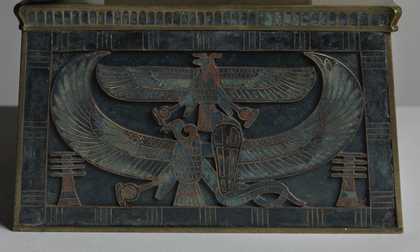
Fig.2
Edward Onslow Ford
The Singer (detail of plinth)
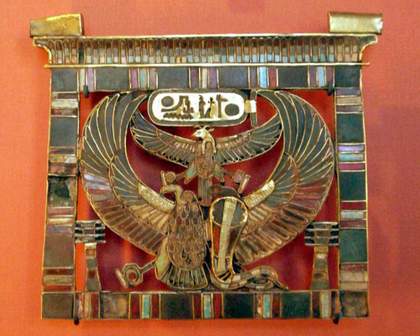
Fig.3
19th-dynasty Pectoral of Ramses II c.1279–1213 BC
Louvre, Départment des Antiquités Égyptiennes (N767)
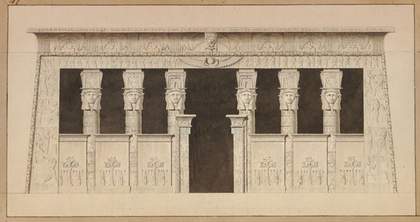
Fig.4
Dominique-Vivant Denon and Louis-Pierre Baltard
The Temple at Dendera 1802, from Voyage dans la Basse et la Hauté Egypte, vol.2, 1802, in plate 39, fig.3
© The Trustees of the British Museum
Motifs of Ford’s neo-Egyptian statuettes show that he studied and worked to make conscious illusion to specific items amid this plethora of Egyptianalia available to him. For example, there is a clear relation between the design gracing the front and back pedestals of The Singer (fig.2) and a nineteenth-dynasty pectoral of the Egyptian pharaoh Ramses II (fig.3), first discovered on 1 March 1852 in the tomb of the Apis Bulls at Saqqara, and now in the Louvre in Paris.4
Ford also evidently derived the overall shape of The Singer’s pedestal either from Dominique-Vivant Denon and Louis-Pierre Baltard’s widely-circulated 1802 illustrations of the temple at Dendera (fig.4).
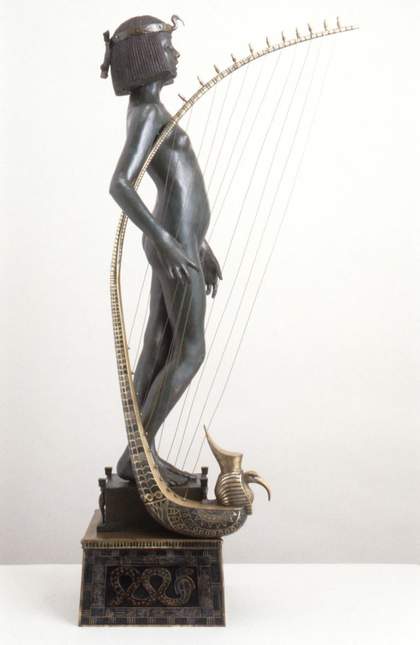
Fig.5
Edward Onslow Ford
The Singer exhibited 1889 (side view)
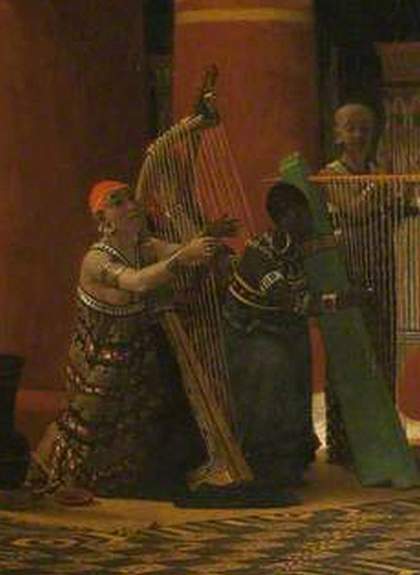
Fig.6
Lawrence Alma-Tadema
Pastime in Ancient Egypt Three Thousand Years Ago (detail) 1863
Harris Museum & Art Gallery
The harp in The Singer (fig.5) may have derived at least in part from Sir Lawrence Alma-Tadema’s Pastimes in Ancient Egypt, Three Thousand Years Ago 1863 (Harris Art Gallery and Museum, Preston, fig.6), and one might speculate that Ford sought, with The Singer and Applause, to create the successful sculptural equivalent of Alma-Tadema’s popular Egyptian canvases. Ford’s neo-Egyptian statuettes seem to follow more closely the example of Alma-Tadema’s preference for more bourgeois, antique scenes than the mid-century Anglo-Roman marbles celebrating the comparatively aristocratic figure of Cleopatra. It should also be noted that the two artists had a close relationship at this particular moment in their careers, emblematised by the painter’s portrait of Ford’s daughter, Clothilde Enid completed in 1888, and Ford’s 1895 sculpted portrait bust of Alma-Tadema (Royal Academy, London). In 1889, the pair also collaborated on furniture for the Marquand Mansion in Manhattan.5 With this in mind, it is possible to speculate that Ford intended his works to appeal to Alma-Tadema, since the painter included an Egyptian-themed room in his studio-home and acknowledged that his Egyptian pictures were his ‘personal favourites’.6
In working on Applause, Ford may also have consulted two architectural slabs in the British Museum, donated in 1766 by King George III: the thirtieth-dynasty slab of Nectanebo I (fig.7) and the twenty-sixth-dynasty slab of Psamtik I (fig.8). If so, Ford may have misunderstood their iconography as the crouching (male) figures are not applauding, but offering to a deity.
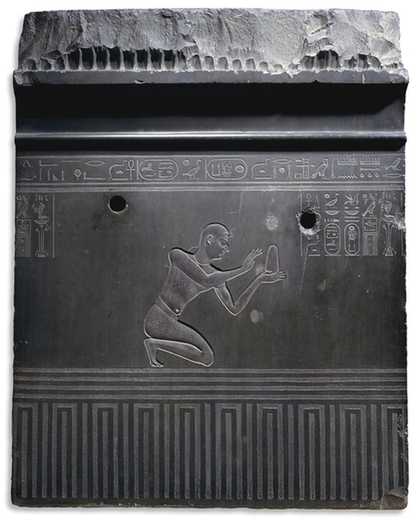
Fig.7
Basalt slab of Nectanebo, Egypt 30th Dynasty, c.370 BC
Gift of King George III (1766)
© Trustees of the British Museum
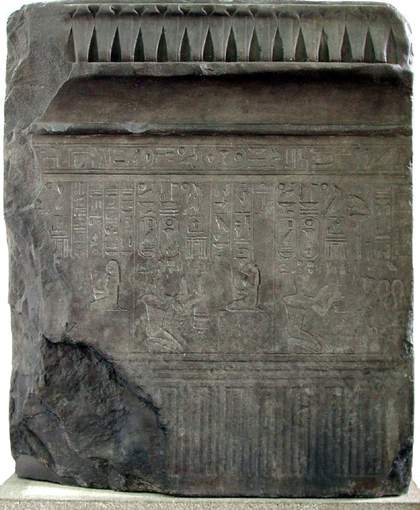
Fig.8
26th-dynasty limestone slab of Psamtik
© Trustees of the British Museum
EA 20
The crown in Applause (fig.9), with its red and turquoise bosses, and intricately braided snake, suggests that Ford may also have attended one of the first performances of Verdi’s Aida in the mid-1870s, or saw an illustration of it, as there is a clear relationship between this crown and a surviving piece of costume jewellery from the production dating from c.1876 (fig.10). There may also be a relationship between The Singer (fig.11) and the designs for the Paris debut of Aida at the Opéra de Paris on22 March 1880, as can be seen when comparing the statuette with Pierre-Eugène Lacoste’s c.1879–80 drawings of the costumes made for the production (fig.12).
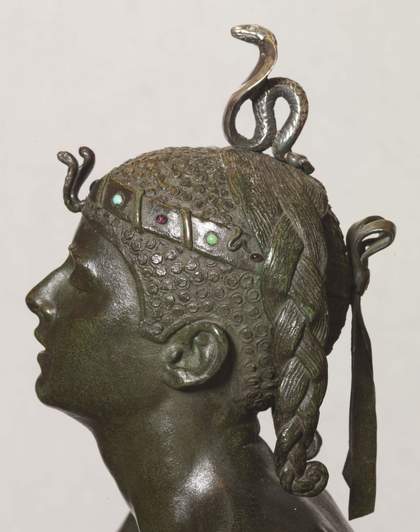
Fig.9
Edward Onslow Ford
Applause 1893 (detail)
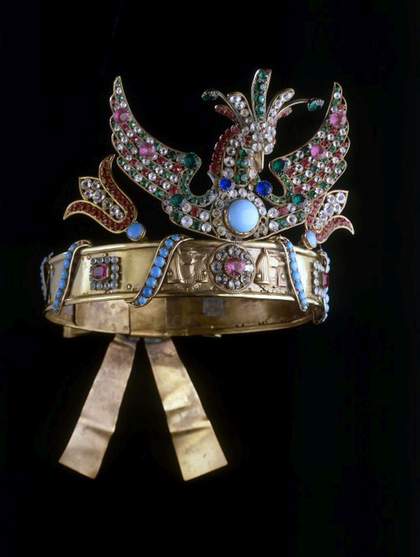
Fig.10
Costume diadem for Aida c.1876
Bibliothèque nationale de France
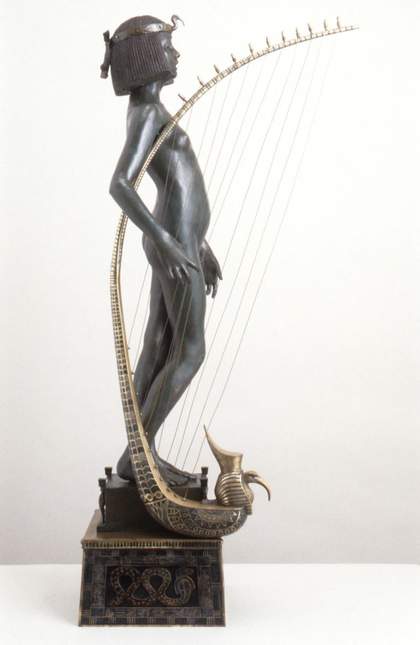
Fig.11
Edward Onslow Ford
The Singer exhibited 1889 (side view)

Fig.12
Pierre-Eugène Lacoste
'Harp Player' costume design (1879–1880) for the Paris Opening of Aida at the Opéra de Paris (Salle Garnier) March 22 1880
Photo: Bibliothèque nationale de France
Thus, although it is clear that Ford drew upon and synthesised an array of ancient and modern sources while working on The Singer and Applause, the meaning of Ford’s eclecticism still needs to be established. This will be done by considering the relationship between the main sculpted figures designed by Ford and the hieroglyphic variants that he depicts in relief form upon the side panels of the two statuettes.
It is important to note, however, that in the bottom-left corner of the right side panel, and the top-right corner of the left side panel of The Singer, there is a miniature, hieroglyphic version of the main figure in Applause (fig.13). Similarly, the top-left figure of the upper register of the orchestra that Ford depicts on the right side panel of Applause, and the top-right figure of the upper register of the orchestra on the left side panel, are miniature, hieroglyphic versions of The Singer (fig.14). What might Ford have intended by this juxtaposition of figures?

Fig.13
Edward Onslow Ford
The Singer exhibited 1889 (detail)
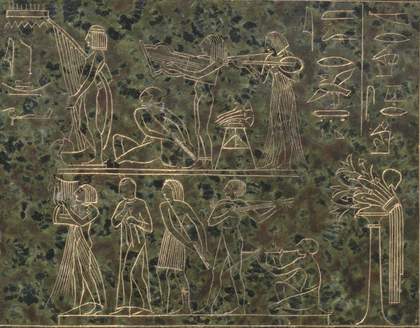
Fig.14
Edward Onslow Ford
Applause 1893 (detail)
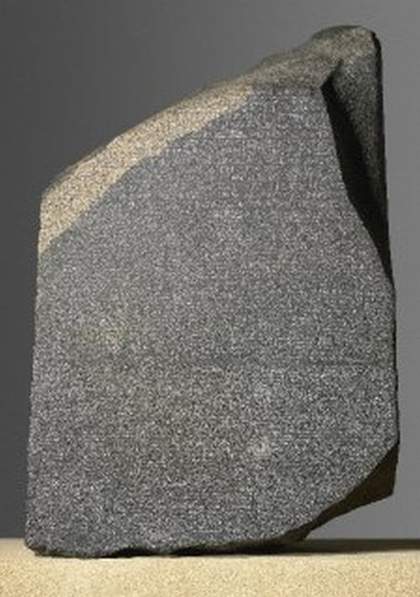
Fig.15
The Rosetta Stone Egypt, Ptolemaic Period, 196 BC, from Fort St Julien, el-Rashid (Rosetta)
Excavated by Pierre François Xavier Bouchard. Gift of George III.
© Trustees of the British Museum
The synthetic use of multiple stylistic sources in late nineteenth-century British art, known today as ‘Victorian eclecticism’, is generally understood as either a product of aesthetic over-confidence (a demonstration of British artists’ certainty that they were able to master all styles from all periods) or as an example of Victorian under-confidence (evidence that British artists, unlike their French peers, were unable to come up with an original modern style, and so returned endlessly to historical precedents). The same criticism has been levelled at the nineteenth-century Egyptian revival, which is more often than not characterised as ‘Egyptomania’, a term that suggests that artists were less concerned with the careful selection and synthesis of sources for a particular purpose, but rather yielded to a tasteless desire for, and lack of comprehension of, ancient Egyptian culture.
However, as the cultural historian James Stevens Curl has argued, Victorian eclecticism and Egyptomania were ‘not a simple matter’ and nor were they ‘merely an exercise in the copying of past styles’.7 With Curl’s insights in mind, Ford’s eclectic pairing of hieroglyphic and fully sculpted figures in The Singer and Applause might be better understood as a sculptural or figurative equivalent of the Rosetta Stone, or a miniaturised, domestic equivalent of the Crystal Palace at Sydenham.
The Rosetta Stone, which entered the British Museum’s collection in 1802, was one of the spoils of the successful British conflict with France in Egypt three years earlier (fig.15). It juxtaposes the same text in two Egyptian scripts (hieroglyphs and demotic) and Greek, which famously enabled Jean-François Champollion to decipher hieroglyphs. By juxtaposing his harpist and applauding figure in two different sculptural ‘languages’ – one hieroglyphic, the other contemporary European – for the purposes of visual translation and comparative evaluation within an imperial frame, Ford may have been trying to develop a visual stylistic equivalent of the linguistic variety on the Rosetta Stone, a kind of ‘Rosetta aesthetics’.

Fig.16
Donato di Niccolò di Betto Bardi
David c.1440s
Museo Nazionale del Bargello
Ford’s contemporaries were evidently aware of the different stylistic vocabularies he simultaneously employed in The Singer and Applause. Writing in The Times on 9 June 1889, an anonymous contributor noted that while there was a ‘certain originality’ in Ford’s having ‘taken the first thought’ of The Singer from ‘Egyptian monuments’, and while the musician’s headdress and harp gave a ‘note of an archaic and Eastern civilization’, the ‘proportions’ and ‘treatment of the form’ were ‘entirely modern’.8 Other critics recognised different historic and geographic allusions in the stylistic treatment of the statuettes. An anonymous contributor to the Leeds Mercury of 16 May 1893 described Applause as the ‘most graceful – one might almost say most Grecian – piece of sculpture’ at the Royal Academy’s Summer Exhibition that year;9 while, five years later, Marion Hepworth Dixon emphasised the affiliations between the down-cast faces and flushed cheeks of Ford’s neo-Egyptian figures and the Renaissance Florentine sculptor Donatello’s bronze David c.1430 (fig.16).10 Indeed, Dixon argued that Donatello was the ‘spring to which every sculptor must, sooner or later, seek to assuage his thirst’, and she documented that Ford had been very ‘happily inspired’ by an earlier ‘pilgrimage’ to Florence to worship at the shrines of the ‘master craftsman of the Tuscan Renaissance’. Dixon also later praised Ford’s A Study for possessing Donatello’s ‘reserve’, ‘dignity’, ‘grace’ and ‘manner’;11 while M.H. Spielmann compared Ford’s wistful figures, with their heads turned down, with the ‘Psyche of Naples’ and the ‘refinement of the quattrocentist Italians’.12 With these numerous examples in mind, Ford’s decision to synthesise multiple styles and to juxtapose two forms of figuration – hieroglyphic relief and fully three-dimensional – might be understood both to reflect ancient Egyptian practice and to manifest in miniature the aims of the Crystal Palace, Sydenham, which offered viewers the chance to compare and contrast both free-standing and architectural sculpture from different art-historical traditions including ancient Egyptian, Renaissance, and contemporary European (fig.17).13
To what extent, though, might the fully three-dimensional, comparatively realistic figures of the two statuettes articulate the imperial triumph of European realistic modelling over Egyptian, relief-carved hieroglyphic stylisation? As cultural historian Stephanie Moser has pointed out, the ‘perceived contrast between Greek movement and Egyptian stasis’, in nineteenth-century histories of ancient sculpture, was a key way of articulating the Victorians’ attitude towards the comparative ‘cultural dynamism’ of Egyptand Greece. Contemporary commentators certainly interpreted the ‘lack of movement’ in Egyptian sculpture as representing both the ‘inferior artistic skill’ of the Egyptians and their culture’s aesthetic stagnation.14 According to Moser, from the publication of J.J. Winckelmann’s History of Ancient Art (1764) onwards, Egyptian art was repeatedly seen as a foil to classicism, and Winckelmann’s ‘progressivist scheme’ for the history of art proved the ‘primary intellectual framework’ according to which the Egyptian antiquities were presented at the British Museum and elsewhere.15

Fig.17
Period photograph of the passageway connecting the Greek, Roman and Egyptian courts at the Crystal Palace Sydenham c.1854–1936

Fig.18
Philip Henry Delamotte
The Colossi Of Aboo Simbel in Process of Painting 1855
Photo © The British Library Board
With this in mind, by drawing a visual parallel between the main clapping figure of Applause and the miniature, hieroglyphic variant on the side panel of the base of The Singer, Ford could be said to encourage reflection on the comparative merits of the two modes of figuration. If so, then Ford’s agenda chimes with the similarly comparative, historicising and imperial aims of Owen Jones’s and Joseph Bonomi’s 1854 guide to the Egyptian Courts of the Crystal Palace, Sydenham. Jones and Bonomi assumed that readers would be familiar with, and proud of the Rosetta Stone, forcibly acquired from Napoleon’s Egyptian troops in 1802. Like the Rosetta Stone, Jones’s and Bonomi’s popular guides invited comparison between several languages, emphasising the authors’ imperial mastery of them all: for example, Jones noted that the Temple of Abu Simbel, discovered by Jean-Louis Burckhardt in 1816 and reproduced at a reduced scale within the Crystal Palace was called ‘Aboo Simbel’ by Arabs, ‘Abshak’ by the ancient Egyptians, and ‘Aboccis’ by Roman geographers (fig.18).16

Fig.19
Edward Onslow Ford
The Singer exhibited 1889 (detail)
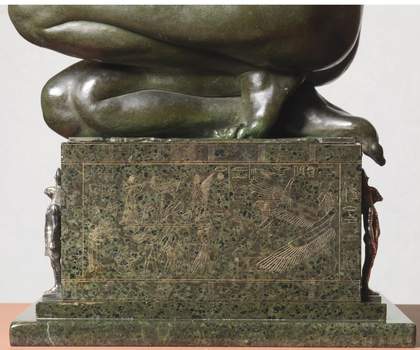
Fig.20
Edward Onslow Ford
Applause 1893 (detail of plinth)
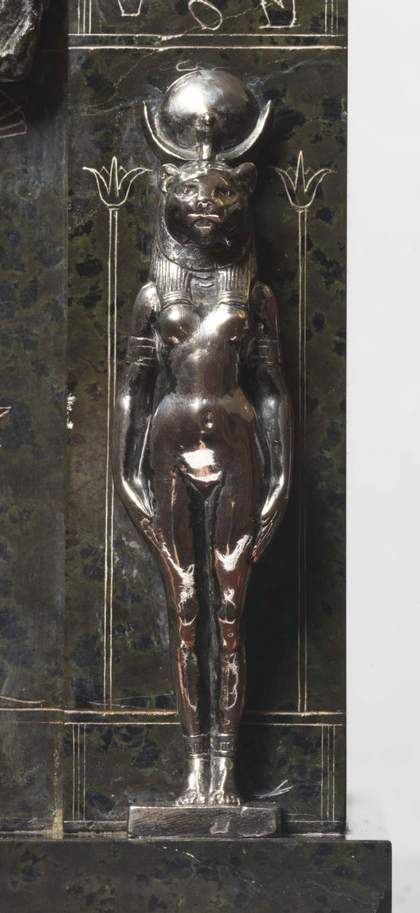
Fig.21
Edward Onslow Ford
Applause 1893 (detail of statuette of Bashtet on back of plinth)
The potentially imperial implications of Ford’s juxtaposition of the anatomical realism of the modelled figures above, with their hieroglyphic variants below, also comes into sharp focus in relation to Victorian art critic Samuel Sharpe’s remarks on Egyptian sculpture in the guide to the Egyptian Courts. Sharpe criticised the way in which Egyptian sculptors often depicted hands resting flat upon the knees, rather than being articulated separately, while Ford ensured that the main figure in Applause has her hands clearly differentiated from, and raised above her knees.17 Similarly, while Sharpe condemned the way in which the fingers and toes within Egyptian sculpture tended to be ‘straight and unformed’, but praised those rare cases in which the toes were ‘spread with the weight of the body’, the fingers of The Singer are powerfully separated and curled (fig.19), and the main figure in Applause rests her weight on her bent, left tip-toes, and flexes her right toes out beyond the back of the pedestal, as the profile and back views make especially apparent (fig.20). While Sharpe felt that Egyptian figures were ‘too short in the waist’, The Singer gently extends the length of her slender torso as she stretches her long body gently backwards; and where Sharpe praised Egyptian sculptures in which the ‘countenance’ was ‘not the usual Egyptian face’ but ‘some attempt at a portrait’, Ford’s attempts to imitate his model’s features was recognised and in fact criticised by some of his contemporaries.18 Finally, in line with Sharpe’s preference for the rare Egyptian works in which the knees were ‘well formed’ and in which the fibula was ‘marked down the leg’, the fibula is emphatically visible in the right shin of The Singer, the realism of which was noted by contemporary reviewers.19 In short, the corporeal details of Ford’s models deliberately possessed the kind of ‘mean or trifling’ effect that, according to Sharpe, prevented the eye from ‘judging the whole’, the gestalt monumentalism that was one of the few qualities of Egyptian sculpture that Sharpe praised.
In this context, it is important to consider the potentially strategic, as well as decorative, function of the four statuettes at each corner of the bases of The Singer and Applause; strategic because these figures seem to exemplify Sharpe’s critical comments on the ‘simple’ attitudes of Egyptian sculpted figures, ‘whether standing or sitting’. Like those that Sharpe criticised, the four caryatid statuettes on the bases of The Singer and Applause ‘look straight forward’ and stand with their hands hanging ‘down on each side’ (fig.21), whereas the bodies of the main figures cannot be said to lack ‘motion’, nor their faces ‘expression’.20
Finally, the two registers of figures, including an outlined harp player that Ford depicts on the side panels of Applause, should also be considered. While the lower register of figures represents what Jones described as the Egyptian ‘attitude of walking’ in the ‘prescribed position’ with ‘the left being in advance of the right leg’, Ford depicts the harpist – similar to The Singer – on the extreme left of the upper register, putting its weight on its forward right leg, while its left leg trails behind (fig.22).21
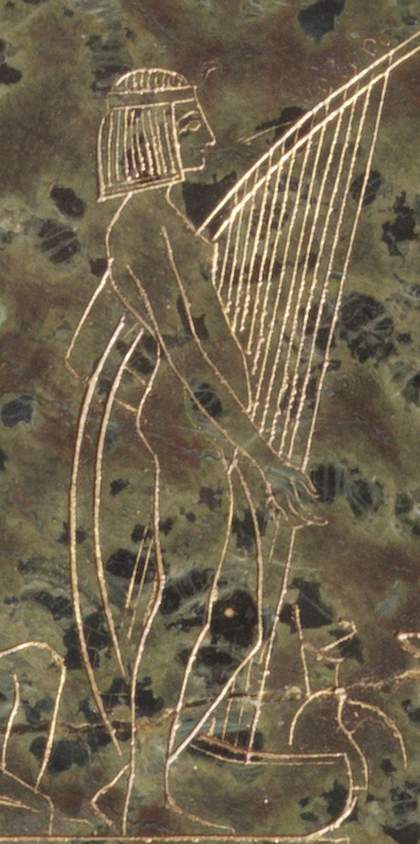
Fig.22
Edward Onslow Ford
Applause 1893 (detail of plinth)
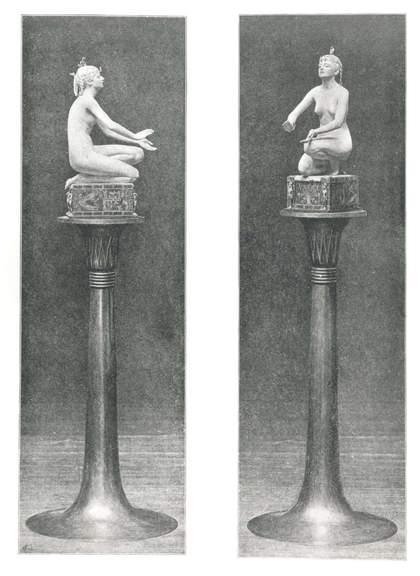
Fig.23
Period photographs showing original pedestal for Applause 1893
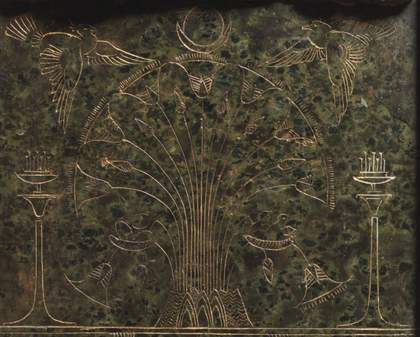
Fig.24
Edward Onslow Ford
Applause 1893 (detail of front plinth)
When it first appeared at the Royal Academy in 1893, Applause was displayed on a now-lost, black-bronze ‘lotus’ base (fig.23) which recalled the ebonised, neo-Egyptian torchères, candelabra and tables Thomas Hope had designed between 1799 and 1804 for his London home, and illustrated in his Household Furniture and Interior Decoration (1805). Half a century later, Bonomi’s and Jones’s guide to the Egyptian Courts of the Crystal Palace in Sydenham also suggested that a ‘lotus flower’ might make a ‘most agreeable stand’, out of which the beauty of a statue could arise.22 And yet, if Ford at first glance seems to follow Jones’s and Bonomi’s intellectual and aesthetic lead, the front and back panels of the pedestal of Applause suggest that the sculptor was keen to differentiate his position, at least from Jones’s later account of Egyptian decorative arts in The Grammar of Ornament (1856). In this highly influential book, Jones argued that ‘graceful symmetry and perfect distribution’ characterised Egyptian design. Jones also appreciated the fact that Egyptian carvers ‘never appear to have gone beyond a symmetrical arrangement’, and he believed that the ‘ideas’ and ‘teachings’ of Egyptian art were ‘the soundest’.23 While the front and back panels of the pedestal of Applause depict an almost perfectly symmetrical scene that could be said to conform to Jones’s taste, Ford differentiated his compositions by employing a nest with two eggs on the left-hand side, and two baby birds on the right-hand side, and by providing a subtle differentiation between the rows of buds above them, with two unlined and one lined on the left, and one unlined and two lined on the right (fig.24).24
In addition, the particular colours Ford employed within the more decorative elements of his statues, as well as the character of that decoration, marked them out as ‘modern’ when compared with mid-century visualisations of ancient Egypt, which were supposedly based on strict archaeological evidence. On the basis of the most recent finds, the Egyptian Courts of the Crystal Palace had sought to emphasise a ‘thoroughly polychromatic’ version of ancient Egypt, dominated by ‘lines of blue, red and green’.25 Unsurprisingly, since Jones was intimately involved with the decoration of the Egyptian Courts, this was also the view of The Grammar of Ornament, which similarly argued that red, blue and yellow were the principle colours used by the ancient Egyptians, with black and white employed to ‘define and give distinctiveness to the various colours’, with green ‘used generally, though not universally, as a local colour’, and with less use of purple and brown (fig.25).26 Indeed, Jones argued that it appeared to be a ‘universal rule’ that primary colours prevailed in ‘all archaic periods of art’, when they were employed ‘instinctively’, ‘harmoniously and successfully’. It was only in later, more ‘traditional’ cultures that there was a ‘tendency to employ the secondary colours and hues, and shades of every variety, though rarely’ and with ‘little success’.27
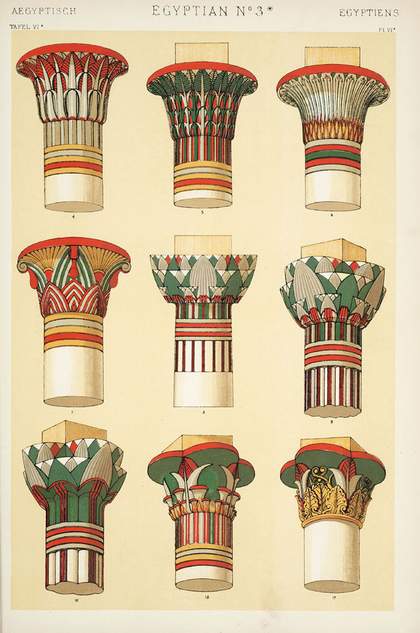
Fig.25
Examples of Egyptian ornaments, from Owen Jones, The Grammar of Ornament (1856)
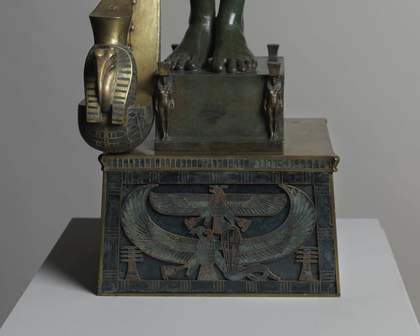
Fig.26
Edward Onslow Ford
The Singer (detail)
By the late 1880s, however, as Ford’s neo-Egyptian statuettes demonstrate, the taste for primary colours and predominant palettes of red, blue, and yellow had changed. For the enamel-work on the pedestal of The Singer, Ford employed ‘flat tints’ and used ‘neither shadow nor shade’, as Jones claimed that the ancient Egyptians had done. Ford was also happy to outline his pedestal serpents and birds against a dark green-to-black background, as Jones had again recommended, using both colour and form ‘conventionally’ in Jones’s terms.28 However, following the fashionable, ‘greenery-yallery’ tones of the aesthetic movement, Ford employed secondary tones of red, blue and green on the base of The Singer, and did without yellow, preferring gold for outlines and highlights (fig.26).29 Ford’s decorative preference for gold highlights in The Singer and Applause, however, were not entirely without Egyptological precedent: Samuel Sharpe claimed in the guide to the Egyptian Courts at Sydenham that the Egyptians had made considerable use of the ‘gold mines of the Nubian desert’.30
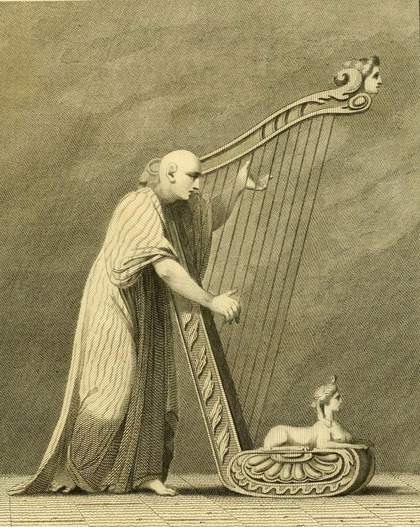
Fig.27
James Bruce, Travels to the Source of the Nile (1813), plate 4
In this comparative and hierarchical context of ancient sources and modern styles, it is useful to consider the links between The Singer and the book Travels to the Source of the Nile, written by the Scottish explorer James Bruce in 1813, as the popularity of the harp motif within Egyptian Revival work dated largely from Bruce’s discovery, in 1768, of the so-called ‘Tomb of the Harpers’, in western Thebes, which contained a bas-relief representation of two blind harpists playing before the gods. It seems likely that Ford was familiar with at least some of this tomb’s iconography given that images of it were widely reproduced. There is a particular resemblance between the harp of The Singer and the instrument illustrated in Bruce’s Travels (fig.27). In both cases, the harps are floor-standing, human-scaled, boat-based, and have more than ten strings. Their bases also feature decorative figures wearing Egyptian crowns: in Bruce’s case, pharaonic figures wearing crowns sacred to the gods Ra and Horus, in Ford’s a red-crown-wearing, ibis-headed Thoth figure. Furthermore, Ford’s and Bruce’s representations both classicise their hieroglyphic source material according to contemporary European standards.
With Bruce’s Travels in mind, The Singer might also be understood as a late-Victorian exemplar of an imaginary paragon between harp designers, ancient and modern. Bruce believed that it was impossible to ‘construct’ or ‘finish’ a harp of ‘any form with more taste and elegance’ than the ancient examples he had unearthed in Thebes, meaning that in the paragon between the arts of ancient Egypt and Greece, harp-making was a rare case in which Egyptian work was ‘more elegant’. Like Bruce’s ancient Egyptian examples, the bottom and sides of Ford’s harp ‘seem to be [ve]neered, and inlaid, probably with ivory, tortoise-shell and mother-of-pearl’, but, in Ford’s case, these are not the ‘ordinary produce of the neighbouring deserts and seas’, as they would have been in ancient Egypt, but, and perhaps more impressively, the product of a trans-continental imperial export business. The juxtaposition in The Singer of a realistic neoclassical figure and a neo-Egyptian harp therefore keeps the question open as to which of the two aesthetic sensibilities was preferred.31
Just as Egyptian art was considered a foil to the classical tradition in European art history, so, too, did Egyptian sculpture function as a foil to the contemporary British sculpture displayed at the Crystal Palace in Sydenham, including the plaster cast of Ford’s General Gordon after it was bequeathed to the directors following the sculptor’s death in 1901. One of the main purposes of the Egyptian Court was to emphasise the comparative skill of modern European and imperially educated colonial sculptors who, like Ford, proved themselves able to master a diverse array of geographical and historical styles. This fact was registered by Jones’s guidebook, which documented that the various statues at Sydenham had been first ‘restored’ by Egyptologist Joseph Bonomi, and then carved in plaster by the Anglo-Italian sculptor Raffaelle Monti and a ‘very intelligent body of French workmen’.32
In spite of how plausible the claims may be for the imperial resonance of Ford’s eclecticism, there is a risk of overstating the idea that the use of ancient source material in Victorian art can only be understood according to historicist, hierarchical or imperial terms. Jones’s and Bonomi’s guidebook, for example, encouraged visitors to the Crystal Palace to contrast the Egyptian ‘Avenue of Lions’ with the contemporary Italian sculptor Antonio Canova’s neoclassical depictions of the same creature, confident that the ‘superiority of the Egyptian idealised form over the attempted imitation of a natural lion carved in stone’ would be ‘very apparent’ to viewers.33 The Singer and Applause may be seeking to make a similar point, suggesting the equivalent status, within Victorian eclecticism, of ancient Egyptian and contemporary European sculpture, or even the richness of ancient Egyptian material culture as a resource for contemporary sculptors. However, the visual hierarchy of the different styles in The Singer and Applause, with the more classical figure produced at a considerably larger scale than the hieroglyphic versions, and the sense in which Ford embeds the hieroglyphics below, as if in an earlier, archaeological strata, may provide the bigger clues to the artist’s aesthetic sensibility.
